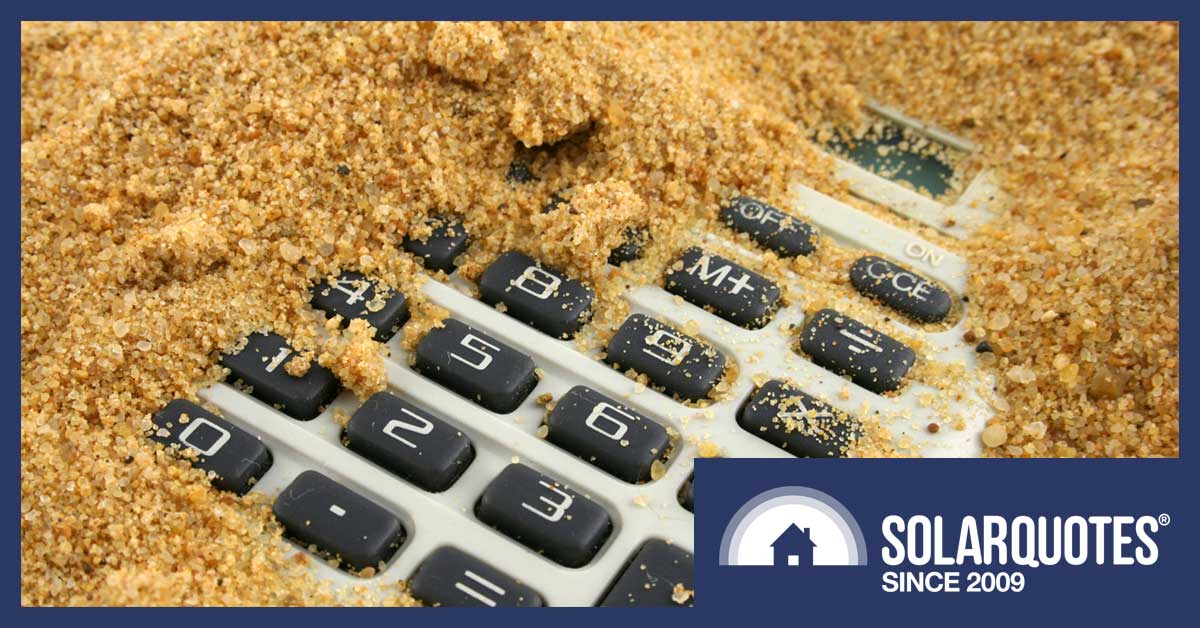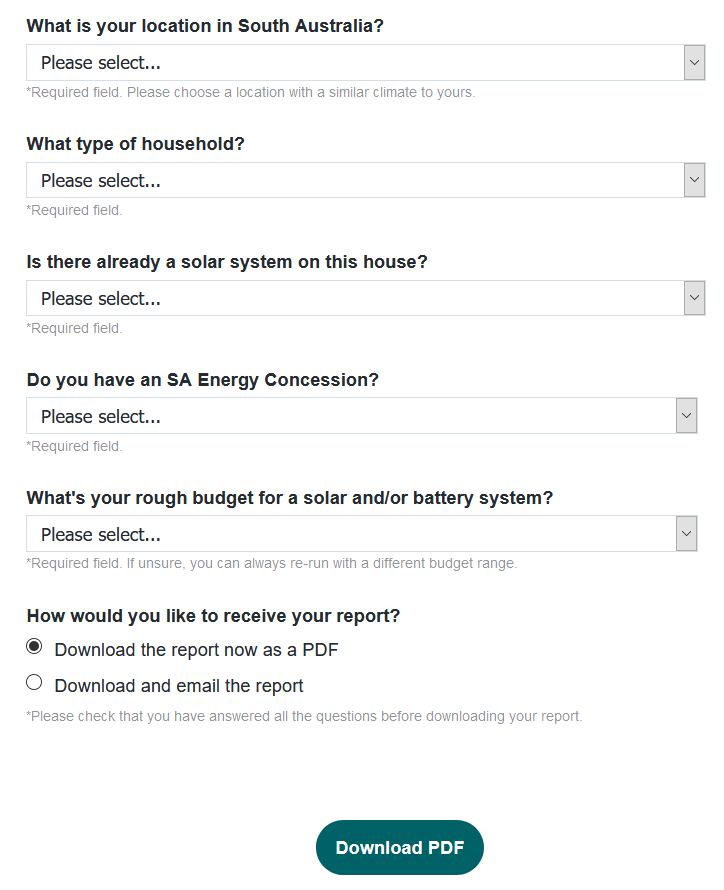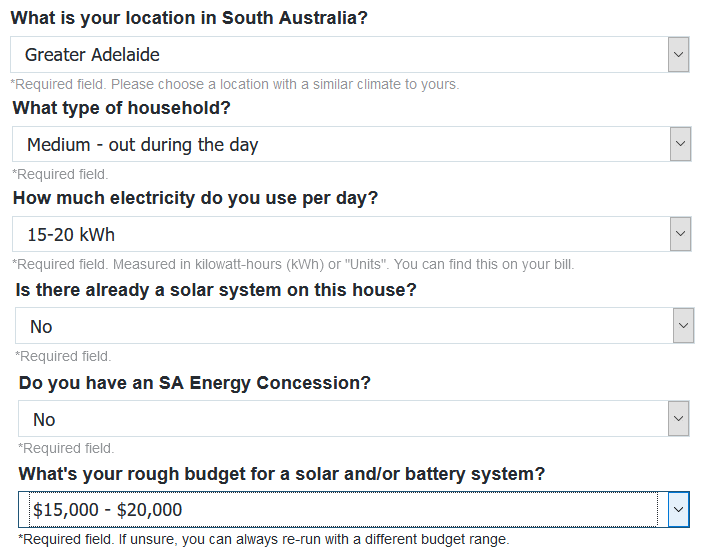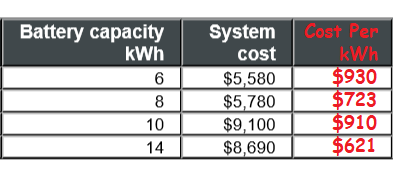
The SA Government commissioned a calculator for their home battery scheme. It shows that, for most homes, even subsidised solar batteries don’t add up yet. So they buried it on their website.
Finally, after one and a half years, the South Australian Home Battery scheme has added a battery calculator to their site. It’s a tool that’s so useful in helping people understand battery savings, I consider it a vital addition to their website.
Why is it that, after spending vast amounts of money promoting their battery subsidy, the South Australian government has only gotten around to adding a battery calculator to their site now? Did someone forget? Did the dog eat their battery calculator budget? Or did they simply not realise that when it comes to new technology, people need some helpful guidance?
I suspect the reason why the battery calculator took so long is that it did not give the answers the state government wanted. Instead of giving subsidised home batteries a glowing recommendation by showing they would soon pay for themselves, the calculator instead shows they are a marginal investment at best for a typical household.
When bought outright a subsidised solar battery’s payback time can be much longer than the warranty period. And if the batteries are financed, they never pay for themselves. This is despite South Australia having the nation’s highest electricity prices and most generous battery subsidy.
I can offer some good news if you’re hoping to get a battery that can pay for itself. The calculator doesn’t include the benefits of joining a Virtual Power Plant (VPP) or any “special offers” you may be able to get. So there is still hope that VPPs and/or price decreases will make batteries pay. Unfortunately, VPPs aren’t yet a proven quantity, and we’ll have to wait and see how beneficial they turn out to be. Fortunately, we can be confident battery prices will fall in the future. (I’m willing to bet 50 cents a major battery maker announces a price decrease1 within the next two months.)
Calculator Made By Renew
The battery calculator was made for the South Australian Government by Renew, and I am confident the one they’ve made does its job well, although I probably wouldn’t say it’s as good as ours. For a start, the SolarQuotes Solar & Battery Calculator is a lot more colourful and didn’t cost the taxpayer a single cent. But there is room in this world for more than one battery calculator, and there’s no need to make them fight to see which one comes out on top. (But I’m still going to ask Finn to put laser claws on ours, just in case.)
The Calculator Makes Assumptions
In addition to not taking into account VPPs or “special offers” (whatever they may be), the SA Home Battery Scheme Calculator makes several assumptions. These include:
- Battery prices are based on their median cost after subsidy and include GST and installation.
- The battery is only used to store solar electricity and reduce grid consumption.
- The battery will degrade to 70% capacity in year 11 and then will fall to 0% in year 21.
- All solar panels are north facing. This means they’ll generate a little more than the average system as many have panels facing east, west, or even south — but hopefully, none facing down.
- The electricity price used is the average of all standard electricity tariffs available.
- The solar feed-in tariff is assumed to be 10 cents.
I’d say the final assumption I’ve listed is the most controversial. According to our Retail Electricity Plan Comparison page it’s possible to get a 22 cent solar feed-in tariff in South Australia right now. This significant difference is important because the higher the solar feed-in tariff, the lower the return from the battery.
While I expect feed-in tariffs to fall in the future, improving the return from batteries, I expect electricity prices to fall too, decreasing the return from batteries. Maybe the 10 cent feed-in tariff figure will be reasonable in the future, but it’s not reasonable now. After all, if you are willing to take the effort to install a battery system, you can bloody well make an effort to change your electricity plan. So while their 10 cents may make sense over 10 years, keep in mind this causes the calculator to overestimate the current return from batteries by a lot.
If your goal is to save money by getting a battery, then the correct time to get one is when it starts saving you money, not before.
The Calculator Is A Little Hard To Find
There is no link to the battery calculator on the front page of the Home Battery Scheme site. That’s where I think it should go. After all, the State Government paid for it with the people’s money, so they should make sure it doesn’t get missed to ensure the people get their money’s worth out of it. But what do I know about web design? Maybe people value things more if they have to search for them?
At the top of the homepage, it’s necessary to click on “Is a battery right for me?” to get to it. I’ve circled (ovaled?) it in red in the screenshot below. I’ve also underlined the word “affordable” and put a big question mark next to it because I’m a frustrated graffiti artist. I only put a small question mark next to the word “reliable” because, despite the depressing reliability of battery systems, the SA Government may know something about the future reliability of the grid we don’t:
After clicking, you then have to scroll down the page that comes up. A little past the halfway mark you’ll find this:
It says it’s free independent advice. That’s something I’m certainly in favour of. I can even remember giving some to the SA Minister for Energy and Mining, Dan van Holst Pellekaan, on batteries. I’m sure he put twice as much effort into acting on it as it cost him.
This is what the calculator looks like:
No Solar-Only Option
If you start to play around with the battery calculator, you’ll find it has a severe flaw. There’s no option for solar-only. This is unfortunate because it prevents people from discovering they will always be better off investing in a more extensive solar power system than a home battery system2. Going big on solar panels is also much better for the environment than buying batteries. But I’m not exactly surprised the calculator doesn’t have this feature.
Using The Calculator — “I’m Just A Typical Home!”
To use the calculator, all you need to do is fill in the fields. They’re pretty straightforward. I did get confused when I tried to enter my location, and it gave me the option of clicking on “Greater Adelaide”. It made me wonder what’s this Adelaide that’s even greater than normal Adelaide I’m used to? But it turns out it just means Adelaide and all its inner and outer suburbs, including nice places like Onkaparinga and the mini-dystopia of Brighton.
To start I entered information to represent a typical household without solar panels. I decided their electricity consumption was average, with no one at home during the day to make them a better candidate for batteries. I also gave their budget for solar and batteries as $15,000-$20,000:
Then I clicked on “Download PDF” to get the report. It gave me the results in two tables. First one was for buying outright and the second one for using finance.
First Table — Solar & Batteries, No Finance
Here are the results it gave for buying solar and batteries without finance:
The first column gives the solar power system size. The two capacities given are 8 and 10 kilowatts and larger than the typical Adelaide system. Larger solar systems improve the return from batteries because they’re better at providing enough energy to charge the battery on cloudy days and/or in winter.
Battery Cost: DC Coupled Vs. AC Coupled
After battery capacity, the next column on the table above is system cost. In the table above it’s the combined cost for solar and batteries. I was able to get the cost for just batteries in the table below by telling the calculator I already had a 10 kilowatt solar system, but this adds in a complication.
If you buy solar and a battery at the same time it’s easy to get a DC-coupled system, which can be cheaper than a retrofittable AC-coupled system. While costs vary considerably between systems, on average DC-coupled will be cheaper. But, while it’s worth keeping it in the back of your head, I wouldn’t worry about it too much because while the difference in cost might help, it’s not likely to be enough to make batteries pay.
The prices in the table below are close to what you’ll need to pay for a battery system, even if you get it at the same time as solar panels.
To make comparisons easier, I’ve added the cost per kilowatt-hour in red. The smallest battery has the highest cost per kilowatt-hour, while the largest has the lowest. But this progression is not smooth. The 10 kilowatt-hour battery jumps up in price and costs almost as much per kilowatt-hour as the 6 kilowatt-hour one. While this seems strange, there are one or two particularly expensive 10 kilowatt-hour batteries on the market that I assume are causing this effect. The low cost per kilowatt-hour of the largest battery is particularly noteworthy because the battery subsidy tops out at $4,000 for 10 kilowatt-hours, so it’s receiving less subsidy per kilowatt-hour than the others.
Blended Payback: It’s A Thing To Avoid
The large table above has a Payback column that gives how many years the solar and battery systems will need to pay for themselves. For all of them, it’s 6 or 7 years. Those aren’t bad payback times and makes batteries seem like a reasonable investment — but only if you’re not aware of the blended payback trap.
Combining the payback of solar and batteries, or blending them, hides how much worse the payback periods of battery systems are. While the table above gives a payback time of 6 or 7 years, let me show you what our calculator gives as the payback time for 8 kilowatt and 10 kilowatt solar systems without batteries in South Australia:

Very short payback for solar-only
While our calculator doesn’t use the same assumptions, it’s clear that adding batteries drags out the payback period. (If you want to play around with our calculator and see what adding various battery systems does to the payback time, feel free.)
Payback Time For Batteries Only
If instead of telling the SA Home Battery Calculator that I want solar panels and a battery, I tell it that I already have a 10 kilowatt solar system, then we see the battery payback time ranges from 10 years to 26 years:
Even with Australia’s highest electricity prices and heftiest battery subsidy, only two of the battery sizes have simple payback periods equal the typical 10 year warranty period for battery systems. While I hope the average battery will last a few years beyond its warranty, it is not reasonable to expect them to last for the 18 and 26 year payback periods given for the 6 and 10 kilowatt-hour systems.
Finance Means Batteries Never Pay For Themselves
In addition to giving information on batteries that are bought outright, the battery calculator also gives information on what happens if you finance a system. Below are the results the calculator generates if you already have a 10 kilowatt solar system and you borrow money to pay for it. For battery systems at these prices, it assumes the interest rate will be 7.28%:
This table doesn’t have payback periods because the batteries will never pay for themselves when financed at this rate. If your goal is to save money, then borrowing to buy batteries is an economic disaster.
What About High Consumption Homes?
The results above are for a home with reasonably typical electricity consumption of around 6,400 kilowatt-hours a year. But what happens if I turn things up to 11 and enter the maximum energy consumption the calculator will allow? Well, that’s precisely what I did, I told it the household has electricity consumption of 60-70 kilowatt-hours a day — an annual consumption of around 24,000 kilowatt-hours, and the results were still bloody awful. Admittedly they were less bloody awful than before, but I was surprised by how little the bloody awfulness had diminished. As you can see here, the best payback time went from 10 years to 9:
If financed is used then, once again, no battery will ever pay for itself. However, you’ll lose a little less money.
Getting solar panels and a battery at the same time could slightly improve things, but I can’t tell by how much since the results are blended. I’m confident it won’t result in any radical change.
No Environmental Benefit From Batteries
The battery calculator gives the reduction in CO2 emissions from installing a solar and battery system, presented as “Equivalent cars off the road”. However, all the CO2 reductions come from the solar energy side of things. To demonstrate this, here is the very first table I showed you, but I’ve removed everything except solar system size, battery capacity, and equivalent cars off the road:
You can see the largest reduction in CO2 emissions occurs when the solar power system size increases from 8 kilowatts to 10 kilowatts. A 25% increase in solar capacity results in around a 25% decrease in CO2 emissions. This indicates the CO2 reductions are due to solar panels alone and not batteries. If you look at the 10 kilowatt solar systems, you’ll see the emissions reductions don’t improve as the size of the battery increases. But, on the bright side, at least they don’t get worse. This isn’t the case with the 8 kilowatt solar systems, as there the larger battery results in slightly more emissions.
Some energy is always lost when charging and discharging batteries, and if surplus energy is directly sent into the grid, it reduces emissions more than using a battery. In the future, home batteries may reduce emissions by storing clean energy that would otherwise go to waste, but this typically doesn’t happen at the moment. The battery calculator clearly doesn’t think it will happen any time soon.
VPPs Will Help (I Hope)
To forestall anyone getting too depressed by these results, I’ll remind everyone they don’t take into account joining a Virtual Power Plant. Becoming a VPP member should improve a battery’s return. But by how much is not clear at the moment. There is also the risk that future reductions in solar export limits will limit VPPs.
Reducing Solar Export Limits Could Kill VPPs
The South Australian grid is having difficulty adapting to the presence of increasing amounts of rooftop solar power. Introducing home batteries, particularly ones connected to VPPs, are one way to help. But if SA Power Networks decides to reduce the amount of power new rooftop solar power systems can export to the grid, it will reduce the return from joining a VPP. If new solar is required to be zero export limited then it makes VPPs useless. If solar exports were to be throttled back, it would make sense to at least exempt homes that purchase batteries and join VPPs, but I’ve found that not everything in life makes sense.
How The SA Government Can Unscrew Their Home Battery Subsidy
I’m quite confident the only reason why it has taken so long for a battery calculator to appear on the SA Home Battery Scheme site is that it tells the truth. That is, batteries can be a terrible investment for a typical household, even with the SA subsidy. This is not what the state government wants people to hear because they believed the hype about batteries and didn’t bother to do the maths first to see if it was true. Unfortunately for them, maths beats hype 99 times out of 98.
But it’s the state government’s lucky day. I have some free and independent advice for them that will make their Home Battery Scheme subsidy look brilliant. It will improve the return from batteries, encourage energy efficiency, increase rooftop solar power uptake, and help pensioners and other low-income earners. Best of all, it won’t cost the state government a cent.
My solution is to eliminate the daily supply charge for electricity while increasing the per-kilowatt-hour charge to make up for it.3 This will make batteries a much better investment while having all the other advantages I mentioned. An additional benefit is, by making electricity bills more transparent and less confusing, it will increase competition in the retail electricity market which should, overall, reduce the cost of electricity in South Australia.
Because this is such a good idea, I’m sure it will be adopted pretty much immediately.
Footnote: After every post of this nature, SQHQ inevitably gets bombarded with messages accusing us of being anti-battery, anti-environment, anti-progress etc. We are not. We love batteries. We know that they are an important part of the 21st Century grid. But telling porky pies about their payback to homeowners is not helping the cause. Especially by the government.
Footnotes
- per kWh ↩
- provided they have suitable roof space ↩
- Some people think the daily supply charge pays for the fixed costs of the grid, but this isn’t how it works. All the money from electricity bills, fixed charges and per kilowatt-hour charges, goes into the same bucket and then gets divided up in a moderately complex way. ↩












 RSS - Posts
RSS - Posts



What do you think of the offer in http://mysunbank.com.au/pilot-plan?
They say “Our Energy Plan will be operating on a Virtual Power Plant model. That means, we will be selling your stored energy in the battery on the open energy market when demand is high, allowing you to sell your energy at times for 10-20 times the current standard feed in tariff.
For example, if you usually sell your energy back to the grid for 11 cents per kWh, you could sell it back at times for $2.50 per kWh. It’s worth noting that we will only do this when it is a financial benefit to you to sell it back at higher rates than what you pay for electricity. And, when the energy price is low or dips into negative (as has happened recently in South Australia) we will still pay you the minimum feed-in tariff. So, we give you plenty of up-side but no down-side.”
I would say be very cautious. I haven’t looked into the details of the plan, so I don’t know how it stacks up. Hopefully, as they say, there is no downside, but I would check for one anyway, even if it is just the opportunity to join a better VPP.
Good review Ronald! The reason a household consuming 60-70 kWh per day still doesn’t get good economics from a battery is that on many days there’s little excess solar generation to charge the battery. Even with a 10 kW system, household appliances are using most generation directly. So the battery spends most of its time empty and is often cycled shallowly, not saving much money.
The households that get least-worst battery economics have a big solar system but moderately-high consumption. It’s an elusive sweeter-spot, which is one reason why home batteries are so tricky, and consumers should definitely do their homework before jumping in.
I would say the whole scheme does not worth the investment. Once the system starts to be profitable the life of the equipment would have expired. Then not much sun in Adelaide to do the trick. People will still need to pay for the grid. Headache without savings that deserve it.
Intetesting!
Synergy have askef if I want to buy a battery for $7,000 or finance it. Also asked for my interest in then joining a VPP.
Size of the battery not mentioned, nor payback. They may be going to call me.
Last bill came in a few days ago – we exported 925 kWh over 63 days, and imported 514 kWh, so our 6.24kW of panels is providing enough for a battery this time of year.
But, saving say $1.60 a day ~$584 per year (approx. average) means not much chance of paying back the $7,000. I suspect there will be other costs as well (installation, control system, inverter?, etc.).
I’ll see what they offer!
I plugged in the following details (closest to my situation) into the calculator:
– House in Greater Adelaide
– Medium household, (in during the day)
– Usage of 15-20Kw per day
– No current system
– Have energy concession
– Budget of $5-10K
The calculator indicated a payback period of 4 years for a 6Kw PV system with a 10KwH battery which is pretty reasonable, don’t you think ?
I paid just under $10K for a 6.6Kw PV system and Tesla Powerwall 2 fully installed. The $10K cost includes the $6000 SA Govt battery subsidy and the Tesla discount which requires joining their VPP.
Hi Saslim
Just be sure to also tell the calculator that you already have a 6 kilowatt solar system so you can see the payback time from the battery alone. As the article points out, when looking at just the battery without solar the payback time will be considerably worse. You may still consider it worthwhile, but just so you know what you are getting into.
Hi Ronald,
I haven’t done as you suggested re checking the payback period for just the battery. However, from my perspective, a payback of 4 years for the $10K investment in the PV-battery package as whole seems quite acceptable.
One aspect that perhaps has often been overlooked is the value a PV-battery system adds to the property when it’s sold. Having continuing electricity supply from the battery backup and/or the solar PV during power outages would probably be quite appealing to potential buyers (as it is to me) … plus the added plus of the money-saving benefits.
We had an outage (in early April) from about 0830 till 1430 without needing to change our electricity usage behaviour at all …. including running a large Panasonic inverter air conditioner (on low cool) for the kitchen-dining-living area.
That’s the great thing of having a Tesla Powerall 2 (and other battery systems also ?) – the ability to continue to use the electricity generated by the solar PV system during power outages which you can’t if you only have a solar PV system.
That’s the great thing of having a Tesla Powerall 2 (and other battery systems also ?) – the ability to continue to use the electricity generated by the solar PV system during power outages which you can’t if you only have a solar PV system.”
….. unless you have a Delta E5 hybrid inverter (reviewed by Michael Bloch in April on this website). But then, the Delta E5 costs $3,000 with is about half the cost of a Tesla Powerwall 2 (installed) if you are eligible for the SA Govt battery subsidy and joint the Tesla VPP for a discount on the price. So it seems to me it would make more sense to spend another $3,000 and get a big-gish battery like the Powerwall 2 instead.
Also, as indicated in Michael Bloch’s article, the Delta E5 won’t be any use at night since there’s no sunlight … or if it’s ovcercast and the solar PVC isn’t generating vert much electricity.
PS. It’s currently cold, windy and wild weather tonight … and we just had a power outage which SA Power Network reckons will be restored at about 11:30pm. Right now, my Powerwall 2 is worth it’s weight in gold !! Looking out over the valley, my place appears to be the only house with lights on. The Powerwall 2 is currently still 89% full so plenty of juice left in it. (Fully charged, it usually lasts all night till about 7 or later by which the sun’s up and it’s getting topped up by the solar PV array.)
I think what this article highlights is how complex the area is – and hence the need for a good calculator.
For example -If I get solar and storage I can get a payback of 6 years. If I retrofit, my payback might be 10 years but if i don’t match the battery size properly it could be 18 or even 26 years.
That’s worth understanding!!
I would guess that even with a grant its going to be tough to make a retro-fit system stack up
But for newcomers -storage and solar as a matched package is definitely worth looking at – and a 5-6 year payback still represents good value against solar only of 3.5 to 4 years.
That low, low payback is driven pretty strongly by feed-in tariffs
Bear in mind, 10c feed in tariffs (let alone 20c tariffs) won’t survive for long with solar coming into SA, VPPs are bring extra value to the table and the smart inverter/storage package adds long term flexibility
there is plenty of transparency on pricing as well.
Batteries wont be for everyone, but they will still make sense for some
Best
Rob
We all forget one important detail whilst discussing the GOVERNMENT battery website above: its government created.
I have been pulling my hair out with government websites for years. The ATO has improved the dog’s breakfast it had a few years ago but many other government entities are still a shambles.
Don’t be surprised that an important link like the that discussed here is not seen on the home page. Its standard government web design: problematic and failed. Reflections of government in general.
I’m quite sure it’s more likely a reflection of the quality of the QA (ie. the usability testing part) undertaken by the developers – whether they be private or public sector people. I worked in IT applications design, development, etc etc for almost 40 years and it didn’t matter whether it was private or public sector – both sectors had excellent as well as some pretty dodgy QA systems; the quality of the systems was often very closely linked to the overall culture of the enterprise culture – especially its management culture – and enterprise management focus (ie. cost vs quality) that the IT units operated within.
An interesting read, but it and the calculators still seem to be looking at the mid to high range system costs rather than the (admittedly higher risk) budget systems. We are in Adelaide. We installed solar PV and solar hot water quite a few years ago, back in 2009. We went for name brand systems for both. Neither was cheap, despite the govt rebates at the time. The solar hot water regularly chews through the circulator pumps (it’s killed three of them since 2009) making it less than good value, but it manages to exist entirely grid free (ie no electric boost needed) throughout summer. The original solar PV system was only a 1 kW system, but was big for the time. The Sharp panels seem ok, but the big German name brand inverter crapped itself a few weeks outside its warranty period, and the big German name brand inverter company is now a swear word in our house, due to the abysmal after sales service that they offered.
Getting on to batteries. After our experience of many years ago, I did a lot of research and sums, and made a conscious decision to go budget for a new solar PV system a couple of years ago, and more recently an AC coupled battery.
$3,500 installed for a 5 kW PV system with Zeversolar inverter and Jinko panels (and the quality of the install was quite good, considering the price). It appears to be working well, regularly exceeding 40kWh/day in summer, and still punching out some good numbers in winter. Payback time within the warranty period is a definite, so it was a no brainer.
After doing lots of payback sums, we went for an AC coupled 10.3kW battery – GoodWe inverter and Alpha batteries. $3,200 installed, and it’s on a VPP network, so we can claim to we good citizens the next time the grid has a fit but is miraculously saved from collapsing in a heap by our little battery. We didn’t go for the backup option in case of grid failure (at extra cost), as we have very reliable power – hang on, was that just the lights flickering for a second??? 😉
Payback time on the battery also should be within the warranty period – just over 4 years payback if my massively over-complex excel spreadsheet is to be believed.
So here we are – an overall investment of $6,700 for 6.6 kW of panels, a 5 kW PV inverter, a 5 kW AC coupled inverter, and 10.3kWh of batteries. Yes, it is a “Hyundai” system, not a “Toyota” system or anywhere near a “BMW” system, but it made the $$ stack up for us.
Hi Dave,
could you please provide details of the business which you have sourced your battery system (AC coupled 10.3kW battery – GoodWe inverter and Alpha batteries. $3,200 installed, and it’s on a VPP network)
Thanks
Agree with Dave Gammon – there are reasonable cheaper options than PW2 now – eg. AphaESS/Goodwe AC coupling which work out to around $3000 for 10kW with the govt subsidy. Surely $3k is workable for a lot of households Ronald?
Also, if we’re assessing the accuracy of online calculators, can you fix the SolarQuotes Fit/ energy calculator one so that it only shows companies you can actually use a 10kW+ power system on? I know it’s so boring reading the fine print, but you gotta make sure your own house is in order if you’re going to be an authority on something.
Hi Mark,
If you are expecting us to be perfect, I hate to disappoint you – we make mistakes – plenty of them – and our free tools (with zero taxpayer subsidy) are not perfect. If we let perfect get in the way of good there would be no SolarQuotes®.
You should see what the website looked like 10 years ago!
Your request has been on our todo list for a long time – we are waiting for that information to be exposed in the data feed of the thousands of plans – until that happens it is impossible. OK, it’s not impossible – but we’d need to hire a team to continuously go through every plan and update the database, and I can’t afford to do that.
Not at all, and I generally think your site it a great resource, but there’s a kind of cynical smugness to some of these blogs which grates when they’re a bit hypocritical or stretching accuracy. Articles which generally encourage people to put in as many panels as they can afford and then a calculator which incorrectly reports great savings from companies who actually limit Solar fit to 5kW max systems – Amaysim are a prime example. Limiting the calculator to 5kW systems would at least make it more accurate in the absence of a known limits. (When I last checked a couple of years ago Origin and AGL were the only 2 companies who did pay fit on 10kW system in SA). Anyway, it’s a great thing if some Adelaidians can make a $3000 dollar battery system economically viable.